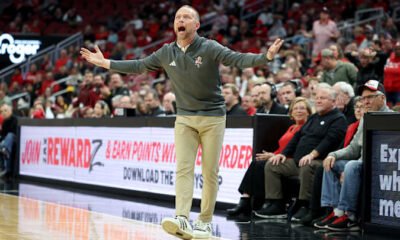Blog
Led Zeppelin’s Physical Graffiti Turns 50: A Monument of Rock Still Towering High
Fifty years ago, in February 1975, Led Zeppelin released Physical Graffiti, a sprawling, audacious double album that would come to define not only the band at their creative peak but the very concept of what a rock record could be. Now, five decades later, the album is being celebrated worldwide, and fans can relive the full experience by streaming it in its entirety on Led Zeppelin’s official YouTube channel. For those who’ve never listened from beginning to end—or for those who haven’t in years—now is the perfect time to sit down, press play, and let the sonic cathedral of Physical Graffiti wash over you. To call Physical Graffiti an album is almost a disservice. It is a landscape. A continent of sound, ambition, and power. Spanning fifteen tracks across nearly 83 minutes, the record weaves together heavy blues, Eastern mysticism, pastoral acoustics, and swaggering funk—all glued together by the unmistakable chemistry between Robert Plant, Jimmy Page, John Paul Jones, and John Bonham. It was Zeppelin’s sixth album, and by this point, they had nothing to prove to anyone but themselves. They were already the biggest band in the world, selling out stadiums, topping charts, and living the mythology that surrounded them. But rather than coast on past glories, the band took their time—two years since their last album—to craft something truly monumental.
The sessions for Physical Graffiti were initially driven by the overflow of material from the Houses of the Holy era. The band had amassed a collection of tracks that didn’t quite fit the previous album’s mold—songs that were too long, too strange, too heavy, or just too different. Instead of letting them gather dust, Zeppelin returned to Headley Grange, the old Victorian house-turned-studio where they had previously recorded much of Led Zeppelin IV. There, in the remote countryside of Hampshire, England, they gave birth to what would become one of rock’s most essential documents. The album’s opening track, “Custard Pie,” kicks things off with a dirty, grinding riff and Plant’s signature vocal snarl. It’s bluesy, punchy, and soaked in attitude. Immediately after, “The Rover” builds on that momentum—an overlooked gem that showcases Page’s layered guitar work and Plant’s lyrical mix of mysticism and rebellion. But it’s with the third track, “In My Time of Dying,” that the record begins to stretch out into something more ambitious. Clocking in at over eleven minutes, the song is a thunderous reimagining of a traditional gospel blues number, anchored by Bonham’s crushing drums and Plant’s haunting pleas. It’s not just a song—it’s a storm.
What’s remarkable about Physical Graffiti is how fluidly it shifts styles without ever losing its identity. “Houses of the Holy,” a leftover from the previous album that ironically didn’t make the cut for Houses of the Holy, adds a splash of funk and playfulness. “Trampled Under Foot” takes that groove and turns it into a full-on dance track, with John Paul Jones’ clavinet leading the way in a nod to Stevie Wonder’s influence. Meanwhile, “Kashmir,” the crown jewel of the record and one of the most iconic tracks in Zeppelin’s entire catalog, arrives like a revelation. Built on a hypnotic, Middle Eastern-influenced riff and swelling orchestration, “Kashmir” is not just a song—it’s an odyssey. Robert Plant later called it the most important Led Zeppelin track of all time, and it’s easy to understand why. Its power lies not just in its sound, but in its vision. It’s the sound of a band unshackled by genre or expectation, reaching for something timeless.
But the majesty of Physical Graffiti doesn’t stop at the hits. The second disc of the album is home to some of Zeppelin’s most emotionally rich and experimental work. “In the Light” is a spiritual journey, led by Jones’ eerie synth and Page’s arpeggiated guitar. “Ten Years Gone” is one of the most heartbreaking songs in the band’s catalog, with Page layering twelve guitar tracks over Plant’s mournful lyrics about love and loss. “Down by the Seaside” offers a rare moment of calm, a gentle and whimsical song that feels like it’s drifting in on a summer breeze, only to be followed by the oddball boogie of “Boogie with Stu” and the rollicking “Black Country Woman.” The album closes with “Sick Again,” a gritty commentary on the dark side of fame and the groupie scene, driven by another monstrous Bonham beat.
Listening to Physical Graffiti in one sitting is not just a musical experience—it’s a commitment. But it’s also a reward. Unlike many albums from the era—or even today—it doesn’t play like a collection of singles or filler tracks. It unfolds like a novel. Each song feels intentional, placed exactly where it should be, and contributing to the whole. This is an album that invites you not just to hear it, but to live inside of it. From the intricate musicianship to the layered production, to the emotionally complex lyrics and genre-defying structures, it’s a masterclass in what rock music can be when there are no limits.
The cultural legacy of Physical Graffiti is hard to overstate. Upon release, it debuted at No. 1 in both the U.S. and U.K., quickly going multi-platinum. Critics hailed it as a masterpiece. Fans devoured it. Musicians studied it. The cover itself—featuring a New York City tenement building with die-cut windows that revealed interchangeable images—became instantly iconic. Even decades later, the album continues to influence generations of artists across genres. From metal to hip-hop, echoes of Physical Graffiti are everywhere.
Now, fifty years on, the celebration of the album’s anniversary is more than just nostalgia. It’s a reminder of what happens when a band dares to push beyond the boundaries of their own legend. In an era of streaming singles and disposable content, Physical Graffiti stands as a towering monument to artistic ambition and integrity. It didn’t try to fit in. It didn’t compromise. And it still sounds as bold today as it did in 1975.
So whether you’re hearing it for the hundredth time or the first, take the time to experience Physical Graffiti in full. Light a candle. Put on headphones. Let it roar, let it whisper, let it guide you through the desert of “Kashmir,” down the alleys of “Trampled Under Foot,” and into the aching heart of “Ten Years Gone.” Because this isn’t just a record. It’s a world. And fifty years later, it’s still waiting to be explored.
Led Zeppelin Announces Historic Super Reunion Tour with Star-Studded Lineup
In a moment that has sent shockwaves across the rock world and beyond, Led Zeppelin—the legendary band that defined an era—has officially announced a long-rumored but never-dreamed-possible reunion tour set for 2025 into 2026. The dates are still under wraps, but the confirmation alone has fans and critics bracing for what could easily become the most anticipated concert event of the century.
It’s not just a tour. It’s a resurrection. A revival. A reckoning. For the first time in decades, Robert Plant, Jimmy Page, and John Paul Jones will take the stage together under the Zeppelin banner, breathing new life into a catalogue that shaped generations. And as if that weren’t monumental enough, they’re bringing along a few of their friends—friends who happen to be rock gods in their own right.
A Dream Lineup of Legends
Among the towering names joining this once-in-a-lifetime odyssey: the metal powerhouse Judas Priest and the elusive guitar genius Ritchie Blackmore. These aren’t mere opening acts or footnotes. These are titans, sharing the spotlight and the stage in a celebration of classic rock’s enduring, defiant soul.
The announcement, made via a cryptic video teaser shared across the band’s official social channels, featured flickering images of Zeppelin’s iconic symbols fading into silhouettes of guitars and stage lights. In the background: a haunting instrumental blend of “Kashmir” and “Stairway to Heaven,” subtly woven with hints of Blackmore’s unmistakable tone.
Seconds before the clip ends, a voice—likely Page’s—whispers, “We never really left.” Then: Tour 2025–2026. Dates TBA.
The Band That Shaped the Sky
Led Zeppelin’s impact is hard to overstate. From the thunderous swagger of Whole Lotta Love to the mythic poetry of Ramble On, their sound defined an epoch of both sonic ambition and raw emotion. Though the band formally disbanded in 1980 following the tragic death of drummer John Bonham, their legacy has only grown in power and prestige.
Reunion rumors have circulated for decades—fueled by brief performances, reissues, and Plant’s continued solo brilliance. But never has there been anything like this: a full-scale tour, a band reborn, with the chemistry that once forged musical lightning rekindled for a new age.
There are murmurs that Jason Bonham—son of the late John Bonham—will again fill in on drums, as he did with power and grace during the 2007 one-off reunion at London’s O2 Arena. Nothing official has been said yet, but industry insiders suggest he’s already involved in rehearsals.
Judas Priest and Ritchie Blackmore: Icons Among Icons
If Led Zeppelin are the mythic kings of hard rock, Judas Priest is its electric heart. Still firing on all cylinders with frontman Rob Halford leading the charge, the British metal legends have refused to fade quietly into legacy status. Their presence on this tour is more than symbolic—it’s elemental. Expect bone-rattling renditions of Breaking the Law, Painkiller, and Hell Bent for Leather delivered with the kind of seasoned fury only Priest can conjure.
Then there’s Ritchie Blackmore—enigmatic, unpredictable, and still peerless in his guitar wizardry. Though famously reclusive in recent years, Blackmore’s involvement is perhaps the most unexpected twist in this already surreal announcement. Known for his trailblazing work with Deep Purple and Rainbow, he’s long danced to the beat of his own Renaissance-tinged drum.
Fans have speculated that his appearance might lead to a supergroup moment—perhaps a once-in-a-lifetime onstage jam between Page and Blackmore, two of rock’s most revered six-string architects. A duel? A duet? Either way, it promises to be unforgettable.
A Celebration, Not a Cash-In
Cynics may be tempted to cast this reunion as a nostalgic cash grab, but those closest to the project say the opposite is true. According to sources, the driving force behind the tour wasn’t money, but legacy—one last chance to celebrate the music that changed the world, with the people who made it, and the fans who’ve kept it alive.
And it’s not just about playing the hits. While the full setlist remains a mystery, insiders hint at deep cuts, unreleased material, and unexpected collaborations between the artists involved. Imagine Halford sharing vocals with Plant on a blues-heavy medley, or Blackmore joining Page on a reimagined “No Quarter.” The possibilities are endless—and exhilarating.
Generations Collide
This reunion arrives at a cultural moment when rock, once feared extinct by streaming algorithms and festival trends, is surging anew. Gen Z fans have discovered Zeppelin through TikTok clips and YouTube rabbit holes. Millennials wear vintage band tees like holy relics. Boomers? They never stopped believing.
This tour won’t just be a nostalgia trip. It’ll be a convergence of generations—old fans reliving their youth, new fans witnessing legends in the flesh, all bound by riffs, rhythms, and reverence.
The Venues, the Vision, the Vibe
While dates and locations are still under wraps, sources suggest the tour will span both stadiums and iconic venues across North America, Europe, and possibly Asia and South America. Each show will reportedly be tailored to its city, with surprise guests, unique set designs, and locally influenced setlists.
Expect immersive stagecraft: vintage visuals mixed with modern projection, subtle nods to Zeppelin’s mystical past, and state-of-the-art sound design to ensure every slide, solo, and scream hits with biblical force.
Merchandise is expected to drop soon, but already fans are speculating about a deluxe tour box set, live recordings, and perhaps even a behind-the-scenes documentary chronicling the tour’s creation.
What It Means for Rock—and for Us
This isn’t just a band getting back together. It’s a story coming full circle.
Plant’s voice may no longer hit every note from his Houses of the Holy days, but his soul still crackles with fire. Page’s guitar may be a little slower, but it still speaks in tongues. Jones’s compositions remain intricate, essential. Together, they still are Led Zeppelin.
Add to that the molten power of Judas Priest and the spectral beauty of Blackmore’s guitar, and this becomes something more than a tour. It’s a cathedral of sound. A celebration of defiance, beauty, thunder, and grace. An elegy and a rebirth. A goodbye and a beginning.
The Final Word—for Now
No word yet on ticket prices or presale dates. But fans are advised to keep an eye on Led Zeppelin’s official channels, as the announcement is expected to come “sooner than you think,” according to one source close to the team.
Until then, speculation reigns. Will there be new music? Guest artists? A final album?
We don’t know. And maybe that’s part of the magic.
But one thing is certain: when those first notes ring out on night one of the Led Zeppelin Super Reunion Tour, it won’t just be a concert. It’ll be history.
Stay tuned to Rolling Stone for exclusive updates, interviews, and backstage coverage of the Led Zeppelin 2025–2026 Reunion Tour. The gods are walking the earth again. And we’ll be there when they do.
-

 Blog5 months ago
Blog5 months agoPat Kelsey sends a strong three-word fiery message to the Louisville basketball’s team after their Cardinals 14th win…
-

 Blog7 months ago
Blog7 months agoNetflix releases “The Underdog,” a much-anticipated documentary about Drew Brees. slated for publication on the 25th
-

 Blog5 months ago
Blog5 months agoMikaela Shiffrin responds to cross-country skier Jessie Diggins’ letter following her failure to secure a solitary podium finish at the FIS Nordic Worlds
-

 Blog3 months ago
Blog3 months agoBehind the Turns: Netflix’s Upcoming Documentary on Mikaela Shiffrin’s Fights, Fears, and Love
-

 Blog4 months ago
Blog4 months agoLegacy Tour Led Zeppelin has officially confirmed their 2026 reunion tour, which will be their first extensive live performances since 2007. The “Led Zeppelin Legacy Tour 2026” will begin on June 10, 2026, at Los Angeles’ SoFi Stadium.
-

 Blog5 months ago
Blog5 months agoWomen’s Slalom Run 1 at the FIS Alpine Skiing World Cup: Are
-

 Blog5 months ago
Blog5 months ago“Courtside to Aisle-Side: Tyrese Haliburton and Jade Jones Set New Wedding Date”
-

 Blog7 months ago
Blog7 months agoFederica Brignone: “I’m fine, but my return to skiing is far off.”
